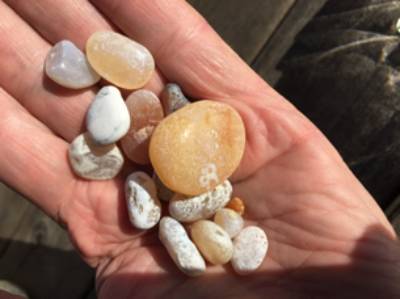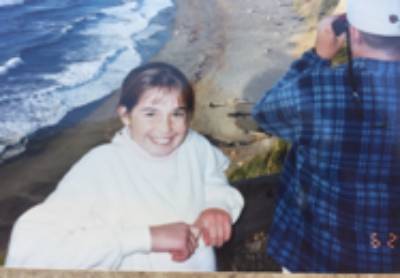
by Dan Rott
“Dad, what’re they doing?” My son Erik stood by my side while we waited for my wife Joan, my daughter Tara and four- year-old Ivan, to catch up with us. They jumped off the last terraced step.
The engineered trail emptied us from the tall bluffs to the ocean beach below. “What’re they looking for dad?” Tara asked when she joined Erik and me on the beach.
Dozens of people were on their knees digging or sifting through sand. Others were walking bent over or stooping to pick up something that caught their eye. A few carried bags or containers with items we didn’t recognize. I saw a man thrust something into his bulging front pocket. We started walking slowly on the large curved beach away from the crowds, but our curiosity grew.
When Joan joined us a few seconds later, she remarked, “Do you think they’re looking for shells?” We kept moving down the beach closer to the large north coast waves with water cracking and pounding the beach into supine like submission. The smell of ocean air washed over our bodies as we ran to stay away from foamy, ocean tendrils pushing in our direction. We loved the coast and the activities that attracted each of us as we explored and played in our own way.
The summer fog was starting to break and the dark, gloomy skies spread apart with translucent patches of alternating shades of gray as light shined through at odd angles. Earlier the drive from Prairie Creek State Park on Highway 101 was slow and tense. “I can’t see a thing. Watch on your side,” I reminded Joan. I squinted like I was reading the small print of an insurance form. A typical tourist magazine available at every stop highlighted Patrick’s Point located 44 miles south of Prairie Creek State Park where we were camping. We decided to travel and explore for the day. We didn’t anticipate the difficulty of driving in the fog, but our luck was changing in many ways.
We loved the coast and the activities that attracted each of us as we explored and played in our own way
On the way back to the stairs in the late afternoon, I couldn’t resist. “What’re you looking for?” I asked a lady who carried a long stick while digging in the sand. Her other hand held a small canvas bag.
“Agates,” she replied with a friendly smile.
"Agates?” I responded almost immediately. “What are agates?”
She stopped and opened her brown canvas bag and pulled out several white translucent stones. Each was rounded and displayed different shades of white and cream. A few were multicolored with alternating clear, milky white and cream shading. No two were alike. I was reminded of the sky when the fog broke hours before.
“If you’re really interested, go talk to John, from Texas,” she advised. “He’s the tall guy with waders, a long-handled scoop and a large brimmed hat.”
“John, from Texas?” I asked with what must have been a quizzical expression on my face.
“He knows everything about agate hunting.” She immediately switched her gaze toward the sandy beach and the patches of rounded beach gravel where most people congregated.
No further time was given to me, and I loudly offered a, “Thank you.”

“Well, what do you think?” I asked the family, but my mind was already made up. I was already heading toward John from Texas. A 30-year relationship was about to begin.
John hunted passionately for agates every chance he got. He lived in San Antonio, Texas with his wife, an elementary school teacher. He stood 6 feet, two inches and was thin for his height. Sharp facial features were clearly visible under what looked like a fly fisherman’s fedora. He wore a long sleeve shirt and fishermen waders complete with angler suspenders. A long arm grasped a threefoot long piece of pvc pipe that had a plastic perforated serving spoon pushed into the opening at the end of the pipe. DuctTape completed the tool, fastening the spoon tightly to the hollow pipe. The scoop snatched agates and colored rocks from the surf and sand.
John and his wife, who spent her time reading books, camped at Patrick’s Point for most of the summer. They packed their large camper style van and drove night and day during Christmas break to reach Patrick’s Point to settle in for five days as John roamed the winter coast looking for the big ones kicked up during big Pacific storms. The beach at the park is known as Agate Beach.

Using the best multitasking technique I’ve ever encountered, John scoured the beach, picking up rocks with his handmade tool, examining them closely, while talking and answering our questions. Every few minutes, he dropped a rock into the clean plastic milk bottle tied to his waste with a short, thin rope. The top section, to the handle, had been cut away by a sharp object so it was easier to use.
“Why don’t y’all poke around and I’ll help you out, if you’re interested,” he kindly offered in a strong Texas accent. He took a moment and pulled several nice stones out of his revamped milk container and let us carefully examine his prize agates of the day. We were as excited as if we were getting a chance to examine gold nuggets.
An hour or two sped by until it was time to go back to Prairie Creek. We all ran back to John to share our harvest of beautiful white rocks. John smiled and reported, “No, not this time. But agate hunting is like fishing. It takes time to get it right.” Our plain white beach quartz were not agates. We vowed to return. That winter, we went to the library and learned everything possible about agates. The next year, with John’s mentoring, we developed “agate eyes” and could spot an agate 10 feet away. We’ve treasured our time at the beach hunting for at least three decades. John, now retired, lives in a small modular home near the park. We still gather as a family once a year for a few days with daughters-in-law and grandchildren as we continue hunting for the big ones.
